The Bizarre Story Of How A Navy F-14 Shot Down An Air Force F-4
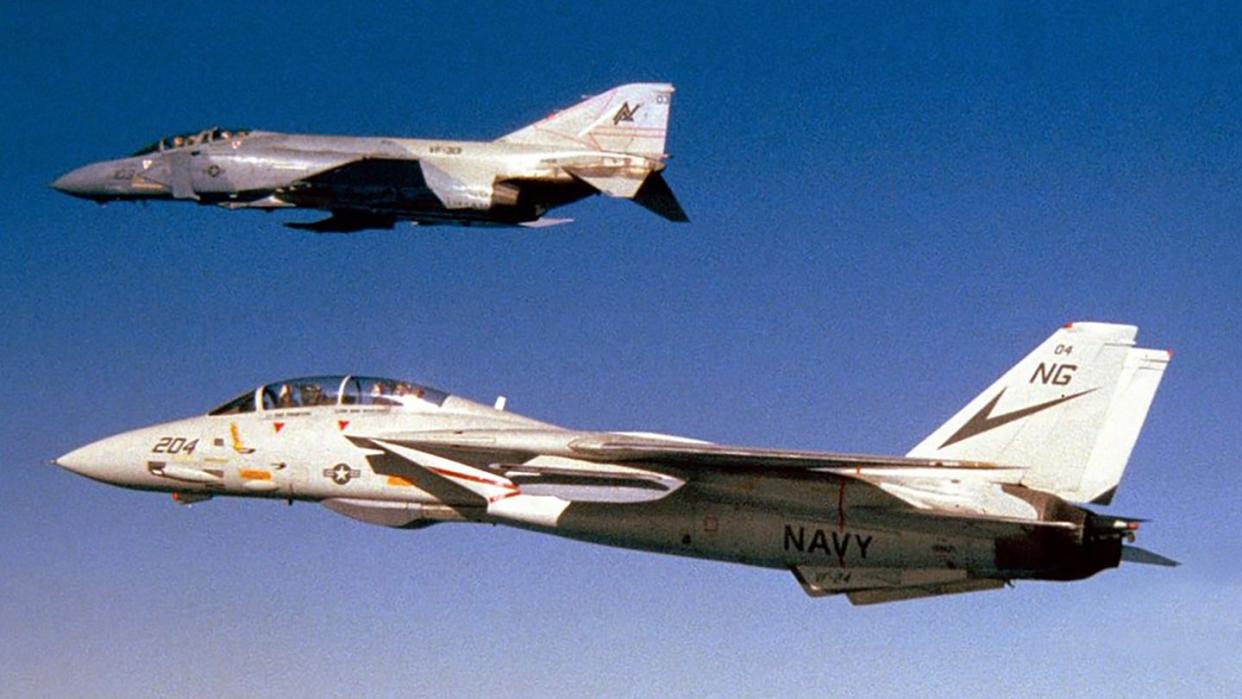
Sometimes, even with all the necessary safety precautions and planning in place, aviation training exercises go horribly wrong. On September 22, 1987, what should have been a routine war game that took place off the Sardinian coastline in the Mediterranean Sea ended with near-fatal consequences for two U.S. Air Force aviators.
At the time, the Forrestal class carrier USS Saratoga was conducting operations in Europe as part of Exercise Display Determination 87 — a NATO war game designed to test U.S. Air Force aggressors against U.S. Navy F-14 Tomcats. However, Lt. Timothy Dorsey, a then 25-year-old pilot with Fighter Squadron 74, the "Be-Devilers," ended up firing an AIM-9 Sidewinder at an Air Force RF-4C Phantom II.
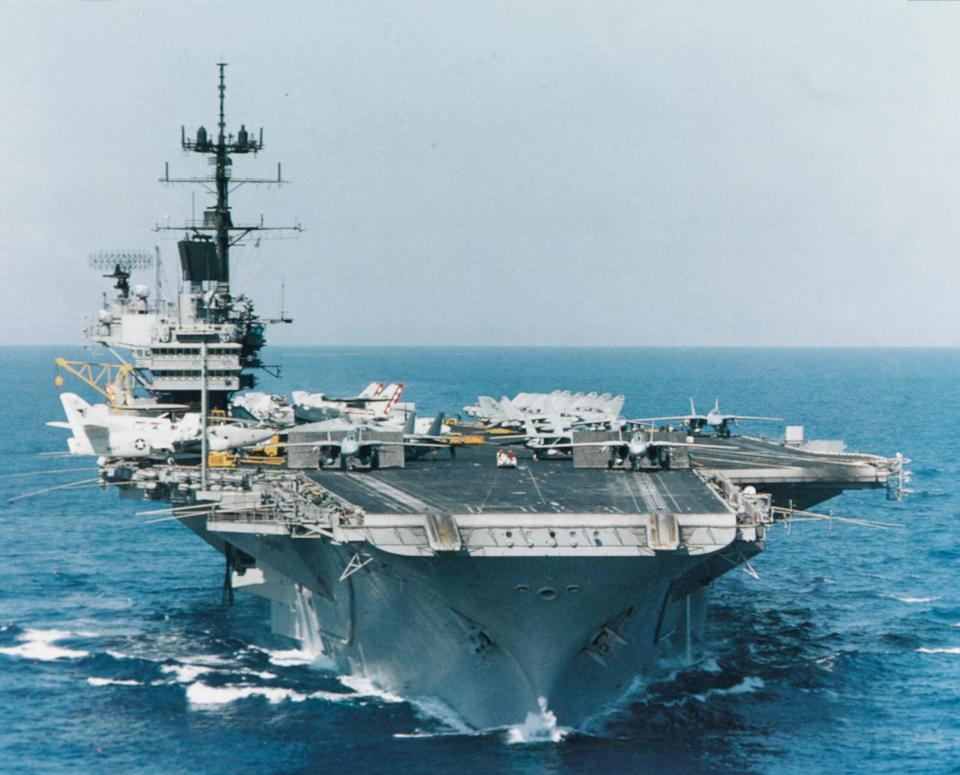
Thankfully, the Phantom's crew — Capt. Michael Ross and Lt. Michael Sprouse — escaped with their lives. The reasons why Ross and Sprouse were placed in such danger form the basis of a remarkably intriguing story that stretches well beyond the immediate aftermath of the incident.
An excellent summary of the events leading up to, and immediately after, the incident is presented in Ward Carroll’s YouTube video below. Carroll is a retired Navy F-14 Radar Intercept Officer (ROI) whose work The War Zone has previously featured.
https://www.youtube.com/watch?v=GeGFWq0lGv8
In theory, the exercise that took place on September 22, 1987, should have been straightforward. Originally, two Air Force F-16s, acting as aggressors, were to be pitted against two Navy F-14s. The F-16s were tasked with finding Saratoga and initiating a mock attack on the vessel, while the two F-14s would attempt to intercept them.
Dorsey was scheduled to fly on the wing of a senior pilot and his skipper — in his own backseat was a senior Radar Intercept Officer (RIO) Lt. Cmdr. Edmund Holland, callsign "Dutch." However, prior to the start of the exercise, Dorsey was informed that he and Dutch would be launching solo, without a wingman.
Immediately before catapulting off Saratoga’s flight deck, Dorsey and his RIO were informed by the strike controller to use the encrypted radio frequency. Once airborne, they were given instructions that their mission had changed, and that they should expect a different vector off the catapult — a set of circumstances which Dorsey felt was strange at the time.
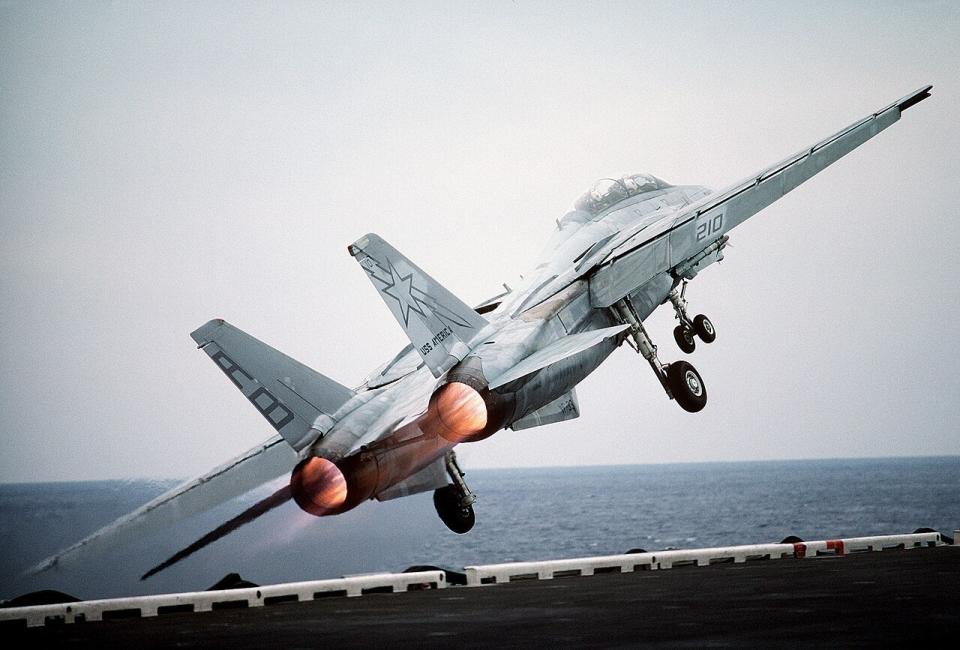
Upon launching, Dorsey was given a vector north to intercept an inbound mock raider. The aircraft in question was a U.S. Air Force RF-4 Phantom, with the callsign "Vodka 51" — launched from Aviano Air Base in the northeast of Italy and flown by Capt. Michael Ross and Weapons Systems Officer (WSO) 1st Lt. Michael Sprouse. Once the RF-4C crossed above the Tyrrhenian Sea, to the west of Italy, it began receiving fuel from a KC-135 tanker, providing sufficient gas for it to locate and 'attack' Saratoga before returning to the mainland.
Dorsey caught up with the RF-4 during its refueling. Sprouse noticed Dorsey's Tomcat when looking over his left shoulder and reported its presence to Ross. From there, the RF-4 completed its tanking evolution and began its simulated attack profile on Saratoga. Dorsey ended up following the aircraft for around 15 minutes as it descended, unsure exactly whether the Phantom was the inbound aggressor he had been alerted to.
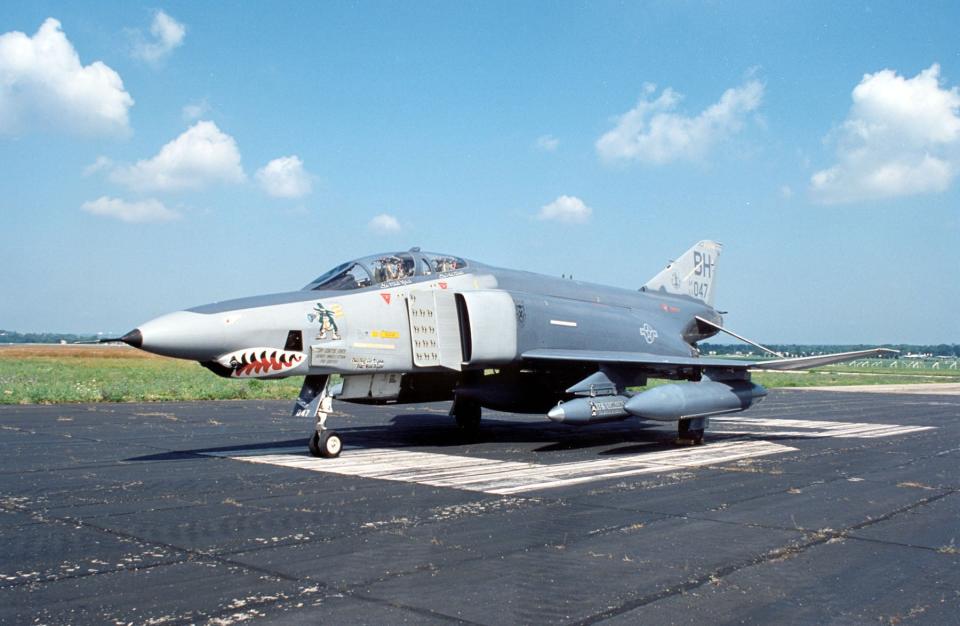
As the Phantom descended, Dorsey attempted to lock up the aircraft using his pilot acquisition modes, but the lock kept breaking due to the RF-4’s jamming pod. Electing to use one of the F-14’s Sidewinders without a radar lock, the Tomcat crew asked for confirmation of their weapons status from strike control. The response, "red and free," was given.
Quoting a story from the Chicago Tribune from April 18, 1988, a more recent Time Magazine piece on the shootdown indicates how shocked Dorsey was to receive the confirmation:
The phrase “red and free” stunned the pilot.
"Jesus!" he said. "Do they want me to shoot this guy?"
"Yeah," Dutch replied. "Shoot!"
The pilot squeezed his trigger.
"I saw the Sidewinder dip low and to the inside of the turn," he later said. "I saw it hit, probably around the stabilator on the port side, and then a big fireball."
The impact of the missile resulted in the Phantom's tail being completely blown off.
The chain of events that occurred immediately prior to Dorsey firing at the RF-4 took place within a matter of seconds. Grainy television camera-set (TCS) footage filmed from the F-14, which includes some radio and intercom exchanges, gives a sense of how it played out.
https://www.youtube.com/watch?v=ycNNWZ79YdY
As Carroll clearly explains in his YouTube video, two important things happened that contributed to the incident occurring, for which both Dorsey and Dutch were responsible.
First, during the footage, Dorsey can be heard saying "there he goes" as the RF-4 began its attack profile on Saratoga. Dutch then replies "101 simulated Fox 2 [emphasis added]." Dorsey clearly did not hear his RIO's instruction for a simulated attack on the Phantom, rather than a live-weapons fire.
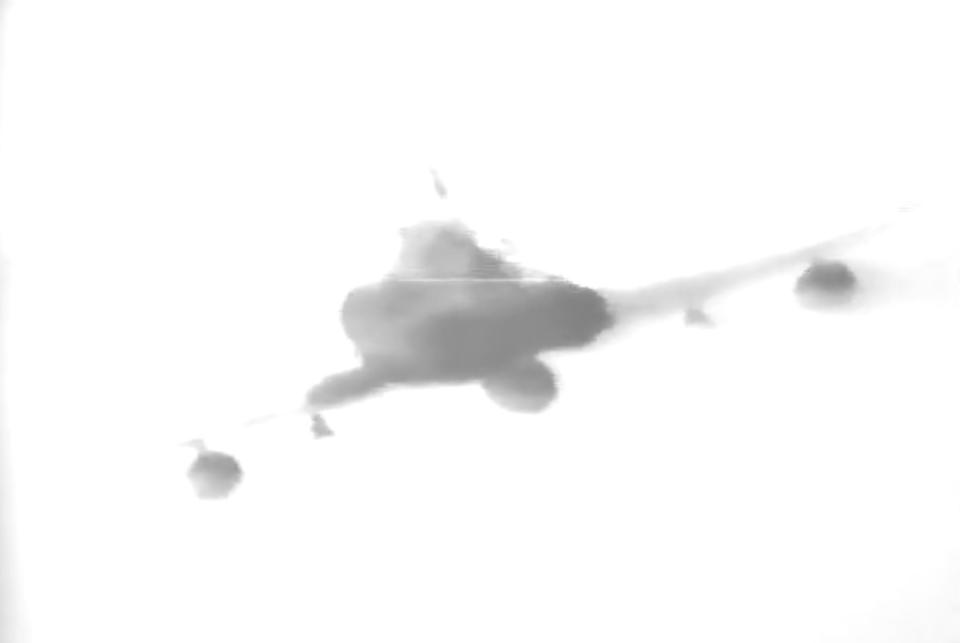
Moreover, had Dutch looked at his Tactical Information Display (TID) in the moments prior to the incident, he would have seen the Sidewinder acronym glowing — indicating the weapon was primed and ready for firing.
Both Sprouse and Ross were forced to eject from the RF-4 at 550 knots (around 632 miles per hour), and landed just five miles away from Saratoga. Thanks to the efforts of the vessel’s SH-3 Sea King rescue helicopter, the pilots boarded the carrier within 45 minutes. However, while it appeared at the time that the pilots were left relatively unscathed from the incident, Ross suffered leg, shoulder, and spine injuries which deteriorated over time, requiring 32 separate back surgeries.
In the aftermath of the event, when Dorsey and Dutch landed back on Saratoga, the maintenance crew noticed the F-14’s missing Sidewinder and scorch marks on the weapons rail from where the missile fired. However, Dorsey remained adamant that the incident was not of his making. During a Field Naval Aviator Evaluation Board (FNAEB) inquiry into the event, during which Dorsey was required to present testimony, he claimed that, from the moment the exercise changed from a two-versus-two configuration, he believed he was operating in a real-world situation.
Dorsey also discussed how he had previously received a failing grade during F-14 training for lack of decisive action after the "red and free" weapons status was given during a simulation, and that such a status required the rapid deployment of weapons.
Other explanations were raised during the FNAEB by Dorsey, including discussion in the days prior to the exercise among Fighter Squadron 74 pilots surrounding "rogue actors" in the region. These individuals were said to have been hijacking military aircraft, and, during the inquiry, Dorsey indicated he suspected the RF-4 had been hijacked during the exercise. However, the FNAEB Board questioned this reasoning, given that Dorsey had seen the RF-4 refueling from an Air Force KC-135.

"Under no circumstances do I consider myself trigger-happy," Dorsey was later quoted as saying in regards to the incident. "If called upon to do so, I’ve been trained to react decisively and smartly. In this most unfortunate mishap, I believe that I indeed reacted decisively and, at the time, with the information I had received and interpreted, believed I was acting smartly. If flying tomorrow, I’d have a heck of a lot more things I’d do differently."
Ultimately, the Board determined that Dorsey could keep his pilot wings, but would not be permitted to fly a Navy aircraft again. As Carroll highlights, many believed that Dorsey was not stripped of his wings because his father, James Dorsey, was captain of the Kitty Hawk class carrier USS America at the time of the incident. According to Carroll, Dorsey senior was similarly responsible for a friendly fire incident during the Vietnam War, during which time he allegedly downed his wingman on accident.
A subsequent 1988 investigative report by the Navy into Dorsey's shootdown was more scathing — excerpts of which are available due to the submission of Freedom of Information Act (FoIA) requests by the Associated Press. According to Adm. Jeremy M. Boorda, the Battle Group commander in 1987:
"The September 22, 1987, destruction of USAF RF-4C was not the result of an accident, but the consequence of a deliberate act. [Dorsey’s] subsequent reaction [to the radio command] demonstrated an absolute disregard of the known facts and circumstances."
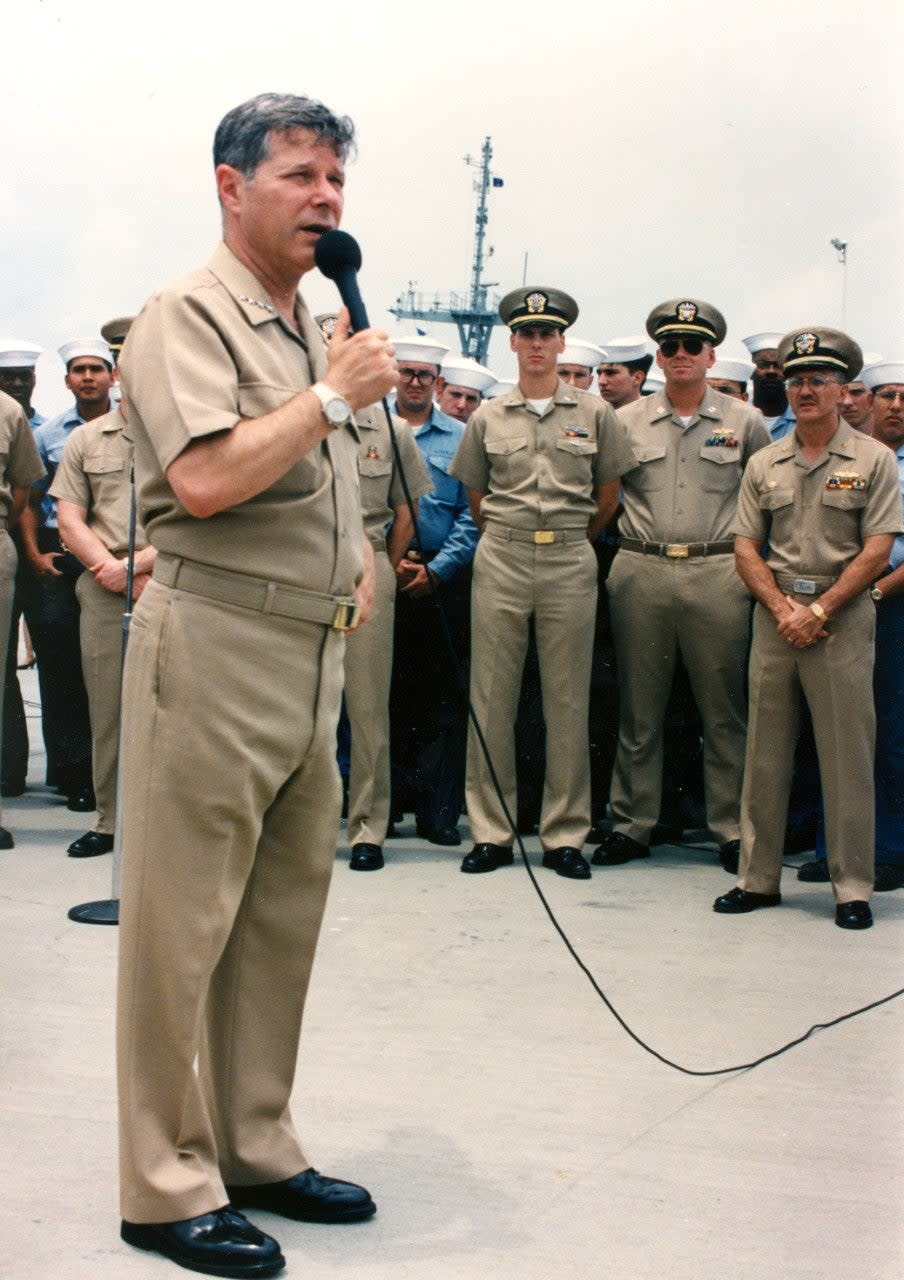
"He failed to utilize the decision-making process taught in replacement training and reacted in a purely mechanical manner," Boorda noted. "The performance of Lieutenant Timothy W. Dorsey on September 22, 1987, raises substantial doubt as to his capacity for good, sound judgment." Boorda’s career with the Navy was brought to a tragic end in 1996, at which time he was Chief of Naval Operations, due to his death by suicide at the Navy Yard in Washington, D.C.
Moreover, Vice Adm. Kendall E. Moranville, who headed Sixth Fleet at the time of the incident, stated in the 1988 report:
"We necessarily rely on the self-discipline and judgment of pilots to prevent such incidents; we have no other choice. Nothing, in my opinion, can mitigate Lieutenant Dorsey’s basic error in judgment."
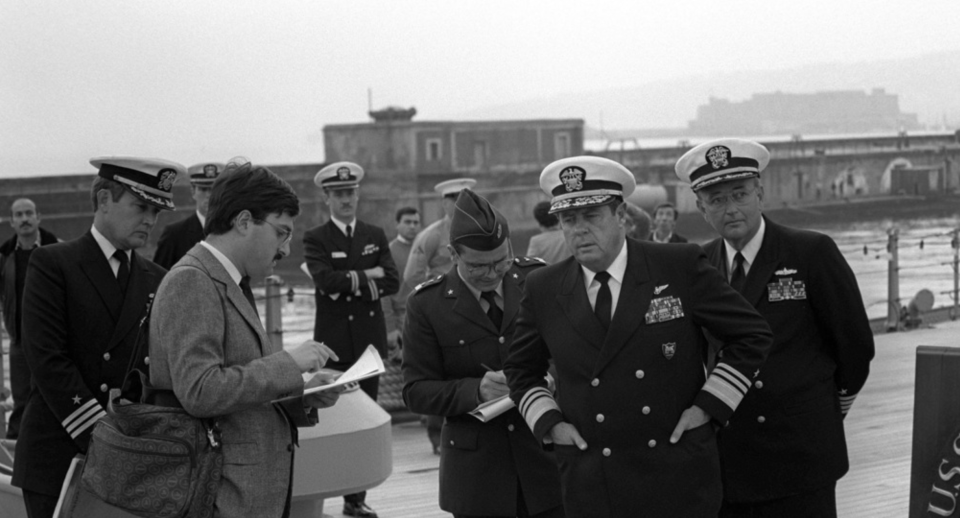
Despite attempts to appeal the FNAEB request, Dorsey left active duty in 1991 and became affiliated with the Naval Reserve Intelligence Program. In 1995, he earned a Juris Doctor degree, graduating magna cum laude from the T. C. Williams School of Law at the University of Richmond. With his intelligence service career flourishing into the 2000s — Dorsey assumed command of Defense Intelligence Agency Headquarters Unit 0466 in 2005 and was later Navy Reserve inspector general, Detachment 106, Norfolk, Virginia — he was nominated for appointment to one-star rear admiral in February 2012.
Upon hearing the news, Ross, who was medically discharged from the Air Force in 1997 — just months before qualifying for a regular pension — at the rank of lieutenant colonel, couldn’t believe it. "I almost got sick… He [Dorsey] ruined my life." The injuries he sustained from the 1987 incident "basically made me 100 percent disabled by Air Force standards," he indicated as part of a 2013 CBS News interview, which can be seen here.
Shortly after the promotion nomination went public, Dorsey sent Ross a letter, which the retired lieutenant colonel believed was intrinsically connected with the Navy’s recommendation to promote Dorsey to rear admiral. The letter read:
"I was unaware you suffered from any lingering injuries [from the 1987 shootdown]… I am truly sorry for the incident and even sorrier for its impact on you."
Although Ross had forgiven Dorsey for his actions by that time, he — and others — complained to members of Congress. The Senate did not act on the Navy’s recommendation of promoting Dorsey, and any such hopes that he might achieve the rank of rear admiral were quashed by early 2013. Dorsey retired from the Navy shortly after in June 2014.
And that's the bizarre story of how a Navy F-14 fired on an Air Force F-4 long after visual confirmation of the target had been established.
Contact the author: oliver@thewarzone.com

